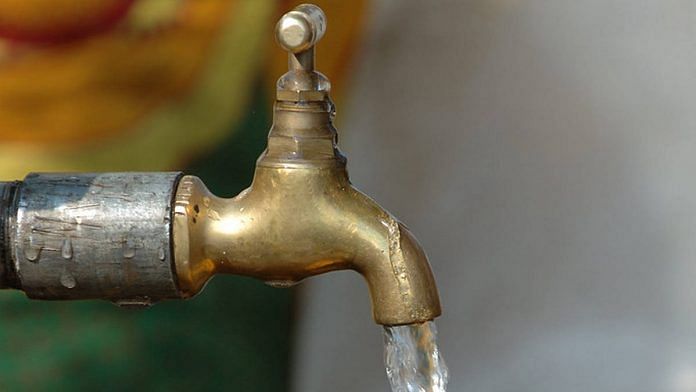New Delhi: Enhance the fees for water and sewerage facilities to recover the operational costs of big-ticket infrastructure projects in the two areas. This is a suggestion offered by the Department of Economic Affairs (DEA), which comes under the Union Finance Ministry, at a meeting on 30 January, ThePrint has learnt.
According to sources privy to discussions at the meeting, the idea behind increased tariffs is to make India’s big infrastructure push under the National Infrastructure Pipeline (NIP) more financially viable.
The January meeting, held by the DEA secretary, was aimed at discussing measures to garner funds for the Modi government’s NIP and put it on a solid footing for the long run.
The NIP is a key pillar of the government’s aim to make India a $5 trillion economy by 2024, which will entail an estimated expenditure of Rs 100 lakh crore on infrastructure. The NIP is meant to oversee and facilitate the efficient execution of projects to make sure India stays on course for its $5 trillion goal.
Speaking to ThePrint, government sources said the DEA suggested tapping user fees as a potential and sustainable resource for upkeep and upgrades of certain projects. The increased water and sewerage tariff, they added, was proposed as a possible starting point before a larger rollout.
Another suggestion discussed at the meeting was that smaller cities should not rush into building metro projects, which are extremely capital-intensive, and instead settle for alternatives like the Bus Rapid Transit System (BRTS).
Also Read: To realise NIP worth Rs 102 lakh crore, Modi govt needs Indians to save long-term
‘User charges for services like water’
The DEA, according to government sources, is of the view that the central and state governments should at least try to recover the operational costs of big-ticket infrastructure projects since they involve heavy capital investment.
“For instance, the meeting discussed levying user fee for water and sewerage facilities,” a government source said.
Currently, many states, including Maharashtra and Uttar Pradesh, have fixed user charges for water — which includes a sewerage component — but they are seen as inadequate vis-a-vis the expenditure incurred in providing the service.
However, the DEA has ruled out setting up a water regulatory authority, on the lines of similar regulators in sectors like power and telecom, to fix tariffs, the source added.
“A water regulator will run into opposition from different quarters, defeating the whole purpose. There is a need to come up with an alternative mechanism to recover the operational costs.”
Proposals to set up water regulators have been mooted in the past too but have met with stiff opposition from different quarters, primarily because they might entail regular tariff increases.
The central government’s proposed National Water Framework Bill 2016, which seeks to put in place a legal framework for water supply in India, also suggests an independent water regulatory authority for providing equitable access at a fair price. But it is yet to see the light of day and hasn’t even come up before the Union Cabinet yet.
Currently, Maharashtra is the only Indian state that has a functional water regulatory authority, but it does not have the power to fix tariffs for domestic water use. Its role is restricted to regulating water use for industrial and irrigation purposes, besides oversight over the supply network.
Union Finance Minister Nirmala Sitharaman had in December announced the government’s decision to launch the NIP, under which the central and state governments will share 39 per cent of the investment each. The remaining funds have to come from the private sector.
Having announced the pipeline, the government has been exploring different funding options as budget allocations offer a limited legroom.
‘Metro rail not feasible for smaller cities’
Another issue that came for discussion at the DEA meeting was Metro projects, a crucial initiative for cities looking to decongest roads as well as ease access for those living on the outskirts.
“There was a consensus that smaller cities should not push for Metro projects as they are hugely capital-extensive and may not be financially viable for states,” said a second government source.
Metro projects are jointly funded by the central and state governments. While the former provides 20 per cent of the capital costs, states put in about 30 per cent. The remaining is borrowed from the market.
Over the last few years, proposals have been mooted for Metro services in Tier-I and Tier II cities such as Chandigarh, Patna, Kanpur, Varanasi and Kochi. The project is already live in Kochi.
“Metro projects could end up burning a big hole in the exchequer at a time when the government is looking at viable alternatives to finance the NIP,” the source added.
Instead of Metro projects, the Union Ministry of Finance wants cities to consider alternatives like the Bus Rapid Transit System.
Also Read: Eye on slowdown, Modi govt revs up infra spending with Rs 1.7 lakh crore outlay




Won’t be easy with Indians.
They have been brought up in a socialist country expecting everything cheap and free…
And it ends up ‘ cheap ‘ and unworthy of human use.
Any service to sustain itself needs a user charge
If it is made free it just ends up being rubbish but ultimately costs more to the consumer in the way of higher tax.
Whose pet baby is this NIP? What is its scope? Who are the beneficiaries, apart from the usual contractor-bureaucracy-neta gang? Why do we need it? In 1974 budget, Indira Gandhi’s government had fixed Corporate Tax at extrordinary level of 97.5%. Are we indirectly going in the same direction under NDA2?
Every western country charges people for water. In UK, that is three thousand rupees for every flat per month, yes, per month. Purification of water costs money.
Modi is all out to stiffle the common man for his obnoxious goals.
Metro could easily have been an independent story…easily missed buried under sewage pipelines…